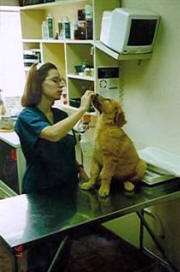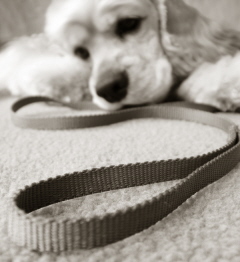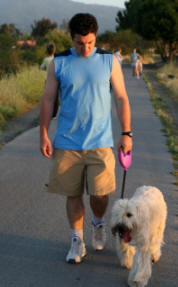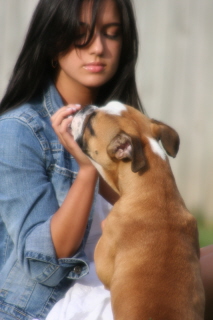|
Need Help?
|
|
Call
1-800-372-3706
to
speak to a Veterinary Behavior Technician |
|
Paws To Speak!
Member
Main Menu
|

Easy Library Links

Puppy Training
Establishing Leadership - Q&A
Leadership Dos
and Don'ts

Pet Professional Tip
Fit
boarding dogs that are unruly with head collars
before walking them to an elimination area. Take
puppies to exam tables and give treats as you slowly
introduce them to positive handling. Use treats as
lures to teach dogs to sit.

Words to the Wise
Remember your dog's
learning becomes solid through many repetitions
and
rewards in many
different situations.
Don't expect
too much
too fast. Learning is a continuous
process, not
a finished product.
Be patient. Keep the sessions short and positive
|
 |
|
Help is at your
fingertips by library, email and
phone. |

Click on
Library Icon
to learn more
|
 Introduction
to Leadership Exercises Introduction
to Leadership Exercises
As a
responsible, loving dog parent,
it is important that you
recognize and provide for your
dog's basic needs.
- Just like
children, you cannot expect dogs
to be seen and not heard ALL the
time. Dogs depend on their
leaders for basic survival which
includes both physical health
and mental well-being.
- Dogs were
not intended to be cooped up
alone in a house or yard day
after day with nothing
productive or entertaining to
do. If you want the joy of
living with a happy, healthy,
well-behaved dog, then you MUST
understand and satisfy your
dog's basic needs.
- Take your dog
to the veterinarian on an annual
or more frequent basis to be
sure your dog is in optimal
health.
- Provide your dog with
daily, exercise, companionship,
and something productive to do.
|
You will reap the rewards of
a well-mannered dog when you
learn what your dog needs
and provide a lifestyle that
prevents common
stress-related behaviors. |
 Following the leader... Following the leader...
IF the
dog is pushy, pulls on the
leash, jumps on you, is
hyperactive, or unruly, THEN use a
head collar such as Behave®,
Gentle Leader®, or Halti®. Leash
control of the nose and head
immediately creates a "follower"
mentality in a dog.
Leaders go through
doorways first
Teach your dog to sit and
wait before entering or exiting any door. If
necessary, hold the dog back by either grasping the
collar or using body blocks (i.e., blocking access
with your body) to teach "wait." Then,
you enter or exit first through doorways.
Leaders lead. If the dog reacts to reaching for the
collar and does not respond to the use of body
blocks, have him or her drag a leash and use this as a handle to teach "wait."
 "Learn to earn" "Learn to earn"
Establish your leadership
by asking your dog to earn
his or her food, petting,
and praise (anything
that the dog wants) by
performing one or more instructions (e.g., "sit/stay").
This is the "Learn to Earn" exercise. Once your dog
will readily obey any known instruction in most any
setting, this suggests he or she recognizes you as a
consistent leader.
Gentling exercises
Then, practice gentling
exercises and physical examinations
frequently at home in a
positive setting. Use food treats, to reward passive acceptance,
then gradually try in gentling exercises in a less familiar
settings to GENERALIZE your leadership position.
position.
Telling your dog to move...
Don't walk around your dog
every time he or she is in your pathway; teach your
dog the instruction "move." Use your voice to
move the dog, not your foot (it is okay to stomp).
This instruction is handy if you have an arm full of
groceries.
No sleeping in your bed
If the dog challenges your
leadership by not responding right away to your
requests, then have the dog sleep on the floor at
the foot of your bed, not on it or on furniture. Use
a three foot leash or a comfy kennel to confine the
dog if necessary. It is best if a bossy, challenging
dog does
not sleep on the owner's bed and is
only allowed on the bed "with permission".
Teaching indoor behavior
Teach your dog quiet
indoor behavior with the Close Tethering
Technique (leash tied to your chair or ankle
when you're home). Praise calm behavior (remember to
reward spontaneously good behavior!) and ignore
tantrums. Give a chew toy.
Teaching the "quiet" correction
Avoid giving your dog what
he or she wants after barking, scratching, whining,
or begging — even if you think the dog looks so cute
and innocent. (He or she is attempting to control
you!). After correcting attention solicitation or
excess barking with a "quiet" correction and
asking for a "sit" instead,
you can give the dog what he
or she wants. Make sure the dog does a few things to
earn what he or she wants so that the barking isn't
a well-planned plot to start this chain of events
that leads to the doggy jackpot!

Stay calm
Avoid losing your temper
when frustrated. You will put your training success
and relationship back months.
Leaders do not lose their cool! Dogs respond
best to reliable, kind, and predictable leadership.
Spend 99.9% of the time praising good or correct
behavior.
Timing is everything!
For reprimanding, use
no physical punishment (with your hands);
instead use verbal scolding but only while the pet
is actually doing the unwanted behavior.
Stop
scolding immediately when
the dog stops the unwanted behavior.
Then, return to being a happy, loving owner. Ask
your dog to sit, to earn positive attention and
praise. If the scolding continues for even two
seconds after the behavior stops, then you are
scolding the pet for stopping!
|